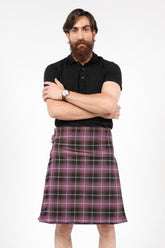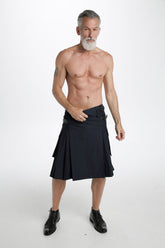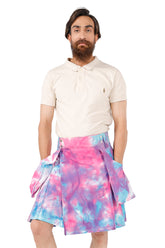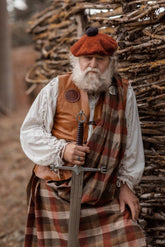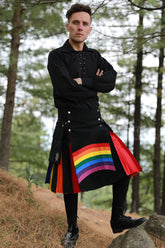All about Kilts - Tartan vs Plaid What’s the Difference
What Culture Wears Kilts?
Kilts, a traditional Scottish garment, are predominantly worn by individuals of Scottish heritage. Rooted in Celtic history, kilts symbolize pride and cultural identity. Scots often wear kilts at formal events, weddings, and celebrations, showcasing a rich legacy that spans centuries. Beyond Scotland, kilts have gained international popularity, with enthusiasts embracing this unique attire as a symbol of tradition and style. Today, kilts are donned by those honoring Scottish ancestry worldwide, reflecting a blend of cultural preservation and contemporary fashion.
The féileadh mòr, or Great Kilt:
The féileadh mòr, or Great Kilt, is a traditional Scottish garment that dates back to the 16th century. It is made from a single piece of wool fabric that is pleated and wrapped around the body, with the excess fabric draped over the shoulder. These kilts were worn by Highland clansmen as a practical garment for warmth and protection, as well as a symbol of their Scottish identity. Today, Great Kilts are still worn for special occasions and traditional events, and is considered an important part of Scottish cultural heritage.
When Were Kilts Invented?
Are you curious about When Were Kilts Invented? If so, you're not alone! The history of the kilt is a subject of debate, with various theories about its invention. The kilt, as worn today, is credited to Thomas Rawlinson, an English manager of an iron-foundry in Lochaber, who is said to have invented it in the 1720s. However, there is evidence to suggest that the kilt was in use before Rawlinson's time, with some experts pointing to earlier use of the walking kilt. The small kilt, which is the kilt we recognize today, became popular in the Scottish Highlands and northern Lowlands by 1746, and its design was later adopted by the Highland regiment of the British Army. The kilt has since remained popular and is worn at formal events, as well as by women in skirt form. Kilts are also recognized worldwide and have a rich and complex history, with influences from various ancient civilizations.
Why Were Kilts Banned?
The ban on kilts, including the tartan kilt, was a result of the Dress Act of 1746, imposed by King George II to suppress Highland culture and prevent further support for the Jacobite Uprising. The act outlawed the wearing of Highland dress, with severe penalties for non-compliance. However, exemptions were made for the Highland Regiments of the British Army and the landed gentry. The ban was lifted in 1782 due to the efforts of the Highland Society of London, ironically leading to a resurgence in the popularity of the kilt. The ban aimed to control the Scottish clans and prevent rebellion, but ultimately failed to extinguish the enduring appeal of the kilt.
What are the Differences Between Tartan & Plaid?
Definition and Characteristics:
- Plaid: Refers to any woven design, typically with a grid pattern formed by horizontal and vertical lines at a 90° angle. It can be of any color or pattern and does not necessarily have a specific cultural or historical significance.
- Tartan: A subset of plaids, distinguished by more intricate motifs and clan associations. Tartans specifically denote a unique pattern associated with a clan or organization. They have a repetitive 'sett' pattern, crucial for differentiation, while plaids may not have this pattern and don't need it.
Cultural Importance:
- Plaid: Generic plaid designs without specific historical or cultural significance.
- Tartan: Carries historical or cultural significance, distinguishing them from generic plaid designs. Tartans have a deeper cultural and historical meaning due to their association with clans or organizations.
Repetitive Pattern:
- Plaid: May not have a repetitive 'sett' pattern and doesn't necessarily require it.
- Tartan: Has a repetitive 'sett' pattern, which is crucial for differentiation and is a key feature that distinguishes tartans from plaids.
Origins & History of Tartans:
The roots of tartans extend to the fifth century, originating with the Scoti tribe and evolving from rudimentary cloth patterns to intricate weaves embraced by Scottish clans. The term 'tartan' likely derived from the French 'tartaine' encapsulates these distinctive plaid designs. The iconic Scottish kilt, possibly inspired by tartan blankets, has become a global symbol of cultural pride. Beyond their aesthetic appeal, tartans serve as familial and historical markers, with specific patterns representing clans and fostering a visual language of ancestral connections. Their application extends to team uniforms, highlighting tartans' enduring significance in both personal and collective expressions of Scottish heritage.
How Many Yards are there in a Tartan Kilt?
Tartan kilts are a traditional Scottish garment that has been worn for centuries. They are made from a length of tartan fabric that is pleated and wrapped around the waist. The amount of fabric used in a tartan kilt can vary depending on the style and size of the kilt.
5 Yard Kilt:
The most common type of tartan kilt is the 5 yard kilt. As the name suggests, this kilt is made from 5 yards of tartan fabric. It is a popular choice for casual wear and is often worn at events such as weddings and ceilidhs.
8 Yard Kilt:
The 8 yard kilt is a more formal style of tartan kilt. It is made from 8 yards of tartan fabric and is often worn for special occasions such as graduations and formal dinners. The extra fabric used in this kilt allows for more pleats, giving it a fuller and more impressive appearance.
In conclusion, the amount of fabric used in a tartan kilt can vary depending on the style and size of the kilt. The 5 yard kilt is the most common type of tartan kilt and is often worn for casual events, while the 8 yard kilt is a more formal style that is worn for special occasions.
Milestones of Tartans:
Tartan, a symbol of Scottish heritage, has a rich history marked by significant milestones:
- The Battle of Culloden (1746): Clan tartans played a crucial role as Jacobite forces, identified by their tartans, faced government forces.
- Disarming Act (1746-1782): Post-Culloden, tartan was banned by the Disarming Act, targeting common Highlander men until 1782.
- Sir Walter Scott's Initiative (1822): Sir Walter Scott's efforts led to the resurgence of tartans, with King George IV encouraging Highland Chiefs to wear their clan tartans.
- Queen Victoria and Prince Albert's Influence: Queen Victoria and Prince Albert's fascination with Balmoral resulted in the creation of the world-famous Balmoral tartan.
Tartan, with its intricate patterns and historical significance, continues to be a cherished symbol of Scottish culture, with over 5,000 tartans in existence and new ones being created annually. The evolution of tartans, from simple checks to elaborate patterns, reflects the cultural and artistic significance of this iconic fabric.
Is Plaid an American Word?
Plaid, commonly associated with a pattern of intersecting stripes, is indeed an American term. Originating from the Scottish Gaelic word 'plaide' meaning blanket or cloak, it gained popularity in the United States during the 19th century. Today, 'plaid' is widely used to describe a distinctive pattern characterized by crisscrossing lines of varying colors and widths in American English.
What is Considered Plaid in the UK?
In the UK, 'plaid' refers to a specific, rectangular piece of tartan worn over the left shoulder, often by grooms at weddings. This distinguishes it from the American usage, where 'plaid' describes any checked cloth of two or more colors, and it is not used to refer to a specific product. The confusion arises from the interchangeability of 'plaid' and 'tartan' in North America, where all tartans are plaids, but not all plaids are tartans.
In conclusion, the evolution of kilts, from the féileadh mòr to the modern-day 8 yard kilt, reflects a fascinating journey through Scottish history and cultural identity. The ban on kilts in 1746 failed to extinguish their enduring appeal, and today, kilts stand as a symbol of pride for those of Scottish heritage worldwide. The intricate world of tartans, with over 5,000 variations and a rich history dating back to the fifth century, continues to be a cherished aspect of Scottish culture. As you explore the differences between tartan and plaid, it becomes clear that the cultural significance of tartans extends far beyond their aesthetic appeal, serving as familial and historical markers. Whether worn casually or for formal occasions, the kilt remains a timeless expression of tradition and style.
Find Your Perfect Fit Today!
Discover unparalleled style with Fashion Kilt – your go-to destination for premium Kilt that redefine fashion. Embrace the timeless allure of kilts and find your perfect fit today! Our curated collection blends tradition with modern elegance, ensuring you stand out on any occasion. From classic tartans to contemporary designs, we offer a diverse range crafted with precision and passion. Elevate your wardrobe and make a statement with kilts that effortlessly blend comfort and sophistication. Explore the exclusive catalog and embrace the versatility of kilts in every stride. Unleash your unique style with Fashion Kilt – where tradition meets trend, and your perfect fit awaits!
FAQs
Can anyone wear a kilt, or is it exclusive to those of Scottish heritage?
Yes, anyone can wear a kilt, and it's not exclusive to those of Scottish heritage. Kilts have become a global symbol, embraced by enthusiasts worldwide.
Are there specific occasions where wearing a kilt is more appropriate?
Absolutely. Kilts are often worn at formal events, weddings, and celebrations. The type of kilt may vary based on the formality of the occasion.
How can one differentiate between a tartan and a plaid pattern?
The key difference lies in the repetitive 'sett' pattern. Tartans have this distinctive feature, while plaids may not. Tartans also carry specific clan or historical associations.
Can women wear kilts?
Certainly. Women can wear kilts, either in the traditional form or as a skirt. Kilts have transcended gender boundaries and are embraced by all.
How do I choose the right tartan for myself?
Choosing a tartan often involves personal preferences or connections to specific clans. Many tartans also have universal appeal, allowing individuals to choose based on aesthetic preferences.

